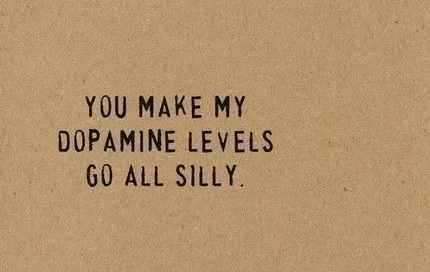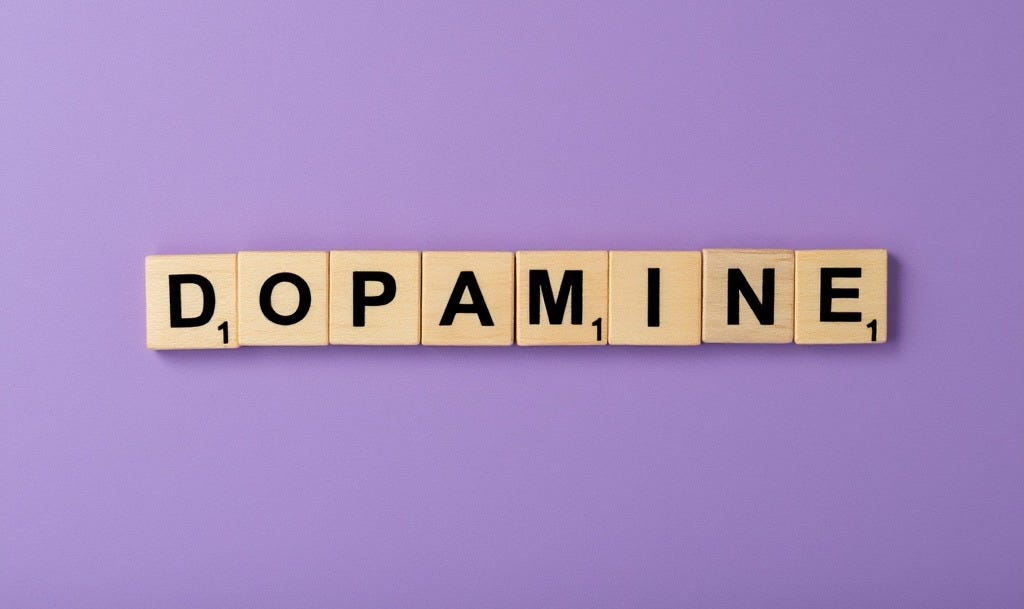We obsess over dopamine, completely infatuated with the idea that we have too much dopamine in our system and that it explains the shift towards hedonistic instant gratification. However, this perspective goes against the entire nature of our dopamine system, ignoring how it is produced and curated. It is suggested that we reduce our dopamine intake to help us survive in the modern world, but this couldn’t be further from the truth.
Dopamine (DA) is a neuromodulator molecule. In essence, this means it is part of the physiological process that regulates a diverse population of neurons, initiating messenger signals across the brain. It is also part of the catecholamine family meaning L-tyrosine is its precursor (more on this later), and approximately constitutes 80% of the catecholamine content in the brain. Simply put, it is a neurotransmitter that sends signals to other nerve cells across its neurological regions. Several dopamine pathways, one of which controls the motivational component of reward-motivated behaviour, create a train track across the amygdala, prefrontal cortex, hypothalamus, and dorsal striatum. As a result, dopamine travels across all regions involved in reward and pleasure, motivation and drive, mood regulation, stress response, anxiety and attention.
But for this whole system to work, our body must have adequate dopamine to be released. For example, if you were to experience some reward or pleasure sensation but did not have enough dopamine to experience said pleasure, your reward system would be classified as impaired. The anticipation, feeling, and motivation would become severely diminished, if not absent, and lead to apathetic behaviour. Therefore, we need to ensure our body can produce enough dopamine.
The most controllable factor for this is through dietary enhancement. First, to produce dopamine, we need its precursors, tyrosine and phenylalanine. The enzyme phenylalanine hydroxylase converts phenylalanine into tyrosine in the liver and kidneys, where it is swiftly transferred to the brain. In the brain, tyrosine enters dopaminergic neurons where it is converted into L-DOPA, which is then converted into dopamine with the help of pyridoxal phosphate (vitamin B6). Post operation, it is stored inside vesicles within the neuron, where it can be released when needed.
However, the problem comes from the phrase “released when needed”. Now, the dopamine system’s decision to release dopamine involves many neural signals, environmental cues, and internal states. But, in essence, when you encounter a stimulus that your hippocampal system has related to reward, the amygdala evaluates the significance, the prefrontal cortex assesses the value, and then our neurons fire dopamine out like a rocket, all of which occurs within milliseconds. Originally, this system was put in place so early organisms could effectively locate and remember locations for food and water sources, alongside procreation. But now, this system is used for everything from the end of the work week; to the pack of Maltesers sitting in the bottom right cupboard of the kitchen; underneath all the rice cakes that we simply cannot forget.
However, you can probably guess that this reward centre is mostly learning-based, not innate. So, this means that this system can be acutely edited based on experiences, preferences, and personality traits. Most dopamine neurons in the brain signal a reward prediction error. In essence, when they are activated by more reward than predicted, this is a positive prediction error, but if they remain at baseline for a fully predicted reward, this is a negative prediction error. Obvious examples of both are a full payout on a slot machine when you’d expect a few pennies and finding out your favourite restaurant no longer serves their tastiest dish upon arrival. Within both scenarios, the anticipation does not equate to the reward, completely editing how our dopamine system works with similar scenarios.
From examples such as these, it becomes obvious how learned behaviour can cause issues such as depression and addiction from simple coding errors. Nevertheless, we know these issues expand far beyond the simplicity of Pavlov’s dog.
Take, for example, our protagonist, Alex. She starts the day with a quick check of her smartphone. The first rush of dopamine comes not from the satisfaction of seeing a message from a loved one but from the mere act of swiping the notification away. This is not about content; it’s about the anticipation, the ‘what if’ of digital interaction akin to the suspense during a horror movie. At work, Alex is in a high-pressure environment where immediate responses and multitasking are expected. Each completed task, each ‘like’ on a social media post, and each buzz from the phone signalling a new interaction sets off a small dopamine cascade. However, over time, these small victories become less satisfying. Alex’s brain, adapting to the frequency of these dopamine hits, now expects more to achieve the same level of pleasure. In the evening, rather than finding solace in going to the gym or reading a book, Alex turns to a takeaway and reality television, where the reward system is explicitly designed to reward dopamine through each bite of pizza, and every pointless argument that makes her feel some intense intellectual superiority. After, Alex meets some friends but feels a constant compulsion to check her phone. The real conversation doesn’t offer the same instantaneous feedback as digital clicks and swipes. The delay in social reward through laughter, agreement, and shared experiences feels too slow and too unpredictable compared to the buzz of her mobile.
This pattern of behaviour has not caused too much dopamine within her body; if anything, she now has too little. Instead, her reward system is attuned to efficiency, out of sync with the environments we were intended to belong. The reward system, primarily involved with essential survival activities such as motivation, has been hijacked by meaningless, yet frequent interactions. Thus, leading to the term ‘dopamine addict’.
But, as with everything mentioned, it is not as simple as “dopamine is the cause” or “just turn off the phone”. The lack of frequent buzzing in your pocket will help, but it will not solve such a multifaceted issue. For example, turn off the phone, and your reward centre will keep salivating at the smell of doughnuts whilst primarily thinking about the football match this weekend.
Instead of just editing our reward system to focus on longer, less accessible dopamine rushes, we should all aim to increase the amount of dopamine within our bodies.
When we experience instant gratification frequently, as most do in the modern world, our body not only becomes desensitised but also less productive. For example, when we engage in hedonistic activities, this neurotransmitter signals pleasurable feelings, but as it adapts, the dopamine receptors down-regulate, reducing how much dopamine is produced. Also, we become more tolerant of its release, needing more to feel its effects, like alcohol and nicotine.
As a result, it is no surprise that depression has a direct correlation with impaired dopamine signalling in many individuals.
So, a recommendation to this ‘dopamine addict’ is to adjust dietary intake. Believe it or not, there are specific foods that support dopamine production. For example, those rich in tyrosine and vitamin B6 (needed for tyrosine metabolisation) have direct roles in dopamine synthesis.
L-tyrosine, commonly referred to as tyrosine, is an amino acid that your body can create from other protein molecules but at an impaired rate. Tyrosine is converted to L-DOPA which we now know converts directly into dopamine. The providers of this amino acid are animal meats and products, everything from turkey and beef to milk and eggs. However, unprocessed soy products, edamame, and seaweed are also high in dopamine. But, if you didn’t eat any of these, simply supplementing L-tyrosine is an option.
Also, with dopamine being the main catecholamine, which also includes norepinephrine and epinephrine (adrenaline), caffeine has been seen to have similar effects on dopamine production as tyrosine, but at a reduced capacity.
Overall, the narrative that our generation is “dopamine addicted” oversimplifies a complex neurobiological issue. While dopamine does indeed play a role in our reward system, attributing modern behavioural patterns ignores human psychology. We’ve explored how dopamine works, its pathways, and how the environment shapes responses. The constant barrage of wishful thinking, digital notifications, escapism, and the unnatural engineered pleasures from food and entertainment have impaired our dopamine systems, but labelling this as an ‘addiction’, to me, is wrong.
Instead of viewing this as an addiction, we should take a more nuanced approach, encouraging environmental and dietary adjustments to increase production and sensitivity. Incorporating foods rich in tyrosine and vitamin B6 is one avenue to take.
Ultimately, the challenge lies in undoing the damage that has already been done, redefining reward to align with how our innate nature intended. To do so, we need to foster slower environments, promote meaningful experiences over fleeting pleasures, and recalibrate this vital system. This shift is not about diminishing dopamine; in fact, it is about its resurgence.




